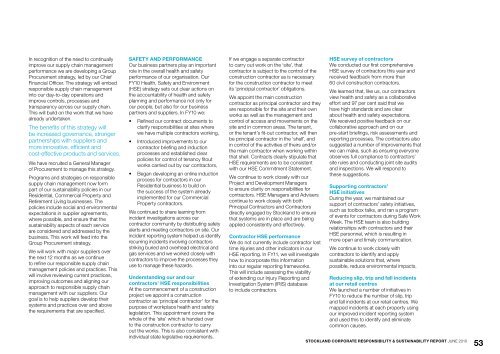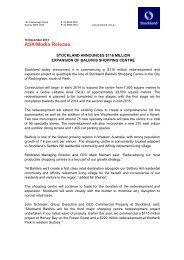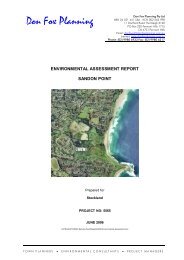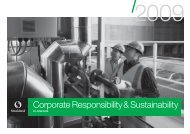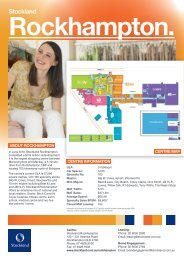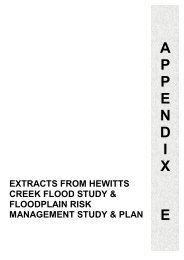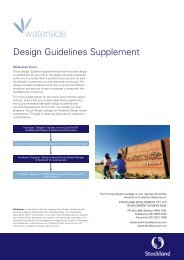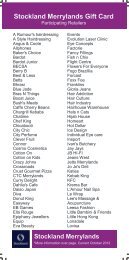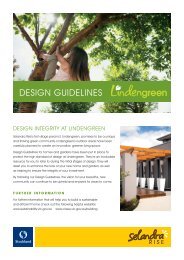Download PDF - Stockland
Download PDF - Stockland
Download PDF - Stockland
You also want an ePaper? Increase the reach of your titles
YUMPU automatically turns print PDFs into web optimized ePapers that Google loves.
In recognition of the need to continually<br />
improve our supply chain management<br />
performance we are developing a Group<br />
Procurement strategy, led by our Chief<br />
Financial Officer. The strategy will embed<br />
responsible supply chain management<br />
into our day-to-day operations and<br />
improve controls, processes and<br />
transparency across our supply chain.<br />
This will build on the work that we have<br />
already undertaken.<br />
The benefits of this strategy will<br />
be increased governance, stronger<br />
partnerships with suppliers and<br />
more innovative, efficient and<br />
cost-effective products and services.<br />
We have recruited a General Manager<br />
of Procurement to manage this strategy.<br />
Programs and strategies on responsible<br />
supply chain management now form<br />
part of our sustainability policies in our<br />
Residential, Commercial Property and<br />
Retirement Living businesses. The<br />
policies include social and environmental<br />
expectations in supplier agreements,<br />
where possible, and ensure that the<br />
sustainability aspects of each service<br />
are considered and addressed by the<br />
business. This work will feed into the<br />
Group Procurement strategy.<br />
We will work with major suppliers over<br />
the next 12 months as we continue<br />
to refine our responsible supply chain<br />
management policies and practices. This<br />
will involve reviewing current practices,<br />
improving outcomes and aligning our<br />
approach to responsible supply chain<br />
management with our suppliers. Our<br />
goal is to help suppliers develop their<br />
systems and practices over and above<br />
the requirements that are specified.<br />
Safety and performance<br />
Our business partners play an important<br />
role in the overall health and safety<br />
performance of our organisation. Our<br />
FY10 Health, Safety and Environment<br />
(HSE) strategy sets out clear actions on<br />
the accountability of health and safety<br />
planning and performance not only for<br />
our people, but also for our business<br />
partners and suppliers. In FY10 we:<br />
• Refined our contract documents to<br />
clarify responsibilities at sites where<br />
we have multiple contractors working,<br />
• Introduced improvements to our<br />
contractor briefing and induction<br />
processes and established clear<br />
policies for control of tenancy fitout<br />
works carried out by our contractors,<br />
• Began developing an online induction<br />
process for contractors in our<br />
Residential business to build on<br />
the success of the system already<br />
implemented for our Commercial<br />
Property contractors.<br />
We continued to share learning from<br />
incident investigations across our<br />
contractor community by distributing safety<br />
alerts and meeting contractors on site. Our<br />
incident reporting system helped us identify<br />
recurring incidents involving contractors<br />
striking buried and overhead electrical and<br />
gas services and we worked closely with<br />
contractors to improve the processes they<br />
use to manage these hazards.<br />
Understanding our and our<br />
contractors’ HSE responsibilities<br />
At the commencement of a construction<br />
project we appoint a construction<br />
contractor as ‘principal contractor’ for the<br />
purpose of workplace health and safety<br />
legislation. This appointment covers the<br />
whole of the ‘site’ which is handed over<br />
to the construction contractor to carry<br />
out the works. This is also consistent with<br />
individual state legislative requirements.<br />
If we engage a separate contractor<br />
to carry out work on the ‘site’, that<br />
contractor is subject to the control of the<br />
construction contractor as is necessary<br />
for the construction contractor to meet<br />
its ‘principal contractor’ obligations.<br />
We appoint the main construction<br />
contractor as principal contractor and they<br />
are responsible for the site and their own<br />
works as well as the management and<br />
control of access and movements on the<br />
site and in common areas. The tenant,<br />
or the tenant’s fit-out contractor, will then<br />
be principal contractor in the ‘shell’, and<br />
in control of the activities of theirs and/or<br />
the main contractor when working within<br />
that shell. Contracts clearly stipulate that<br />
HSE requirements are to be consistent<br />
with our HSE Commitment Statement.<br />
We continue to work closely with our<br />
Project and Development Managers<br />
to ensure clarity on responsibilities for<br />
contractors. HSE Managers and Advisers<br />
continue to work closely with both<br />
Principal Contractors and Contractors<br />
directly engaged by <strong>Stockland</strong> to ensure<br />
that systems are in place and are being<br />
applied consistently and effectively.<br />
Contractor HSE performance<br />
We do not currently include contractor lost<br />
time injuries and other indicators in our<br />
HSE reporting. In FY11, we will investigate<br />
how to incorporate this information<br />
into our regular reporting frameworks.<br />
This will include assessing the viability<br />
of extending our Injury Reporting and<br />
Investigation System (IRIS) database<br />
to include contractors.<br />
HSE survey of contractors<br />
We conducted our first comprehensive<br />
HSE survey of contractors this year and<br />
received feedback from more than<br />
60 civil construction contractors.<br />
We learned that, like us, our contractors<br />
view health and safety as a collaborative<br />
effort and 97 per cent said that we<br />
have high standards and are clear<br />
about health and safety expectations.<br />
We received positive feedback on our<br />
collaborative approach and on our<br />
pre-start briefings, risk assessments and<br />
reporting processes. The contractors also<br />
suggested a number of improvements that<br />
we can make, such as ensuring everyone<br />
observes full compliance to contractors’<br />
site rules and conducting joint site audits<br />
and inspections. We will respond to<br />
these suggestions.<br />
Supporting contractors’<br />
HSE initiatives<br />
During the year, we maintained our<br />
support of contractors’ safety initiatives,<br />
such as toolbox talks, and ran a program<br />
of events for contractors during Safe Work<br />
Week. The HSE team is also building<br />
relationships with contractors and their<br />
HSE personnel, which is resulting in<br />
more open and timely communication.<br />
We continue to work closely with<br />
contractors to identify and apply<br />
sustainable solutions that, where<br />
possible, reduce environmental impacts.<br />
Reducing slip, trip and fall incidents<br />
at our retail centres<br />
We launched a number of initiatives in<br />
FY10 to reduce the number of slip, trip<br />
and fall incidents at our retail centres. We<br />
mapped incidents at each property using<br />
our improved incident reporting system<br />
and used this to identify and eliminate<br />
common causes.<br />
<strong>Stockland</strong> Corporate Responsibility & Sustainability Report June 2010<br />
53


